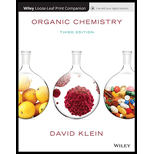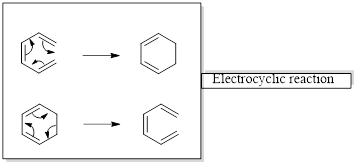
ORGANIC CHEMISTRY-PRINT COMPANION (LL)
3rd Edition
ISBN: 9781119444251
Author: Klein
Publisher: WILEY
expand_more
expand_more
format_list_bulleted
Question
Chapter 16.9, Problem 22ATS
Interpretation Introduction
Interpretation: The product has to be identified and the reason for not forming the other product has to be determined.
Concept Introduction:
There are mainly three types of pericyclic reactions,
- 1) Electrocyclic reactions.
- 2) Cycloaddition reactions
- 3) Sigmatropic reactions
In an electrocyclic reaction “one new sigma- bond is formed or broken.”

If the two orbitals rotate in same direction, then it is called as con rotation and if it is in opposite direction, then it is called dis rotation.
Expert Solution & Answer
Want to see the full answer?
Check out a sample textbook solution
Students have asked these similar questions
3. Provide all the steps and reagents for this synthesis.
OH
Steps and explanation
Steps and explanations please.
Chapter 16 Solutions
ORGANIC CHEMISTRY-PRINT COMPANION (LL)
Ch. 16.1 - Prob. 1CCCh. 16.2 - Prob. 2CCCh. 16.2 - Prob. 3CCCh. 16.2 - Prob. 4CCCh. 16.3 - Prob. 5CCCh. 16.4 - Prob. 1LTSCh. 16.4 - Prob. 6PTSCh. 16.4 - Prob. 7PTSCh. 16.4 - Prob. 8ATSCh. 16.5 - Prob. 2LTS
Ch. 16.5 - Prob. 9PTSCh. 16.5 - Prob. 10PTSCh. 16.5 - Prob. 11ATSCh. 16.5 - Prob. 12CCCh. 16.7 - Prob. 3LTSCh. 16.7 - Prob. 13PTSCh. 16.7 - Prob. 14ATSCh. 16.7 - Prob. 15CCCh. 16.7 - Prob. 16CCCh. 16.7 - Prob. 17CCCh. 16.7 - Predict the regiochemical outcome (major product)...Ch. 16.8 - Prob. 19CCCh. 16.9 - Prob. 20CCCh. 16.9 - Prob. 4LTSCh. 16.9 - Prob. 21PTSCh. 16.9 - Prob. 22ATSCh. 16.10 - Prob. 23CCCh. 16.10 - Prob. 24CCCh. 16.10 - Prob. 25CCCh. 16.10 - Prob. 26CCCh. 16.11 - Prob. 5LTSCh. 16.11 - Prob. 27PTSCh. 16.11 - Prob. 28ATSCh. 16.12 - Prob. 29CCCh. 16 - Prob. 30PPCh. 16 - Prob. 31PPCh. 16 - Prob. 32PPCh. 16 - Prob. 33PPCh. 16 - Prob. 34PPCh. 16 - Prob. 35PPCh. 16 - Prob. 36PPCh. 16 - Prob. 37PPCh. 16 - Prob. 38PPCh. 16 - Prob. 39PPCh. 16 - Prob. 40PPCh. 16 - Prob. 41PPCh. 16 - Prob. 42PPCh. 16 - Prob. 43PPCh. 16 - Prob. 44PPCh. 16 - Prob. 45PPCh. 16 - Prob. 46PPCh. 16 - Prob. 47PPCh. 16 - Prob. 48PPCh. 16 - Prob. 49PPCh. 16 - Prob. 50PPCh. 16 - Prob. 51PPCh. 16 - Prob. 52PPCh. 16 - Prob. 53PPCh. 16 - Prob. 54PPCh. 16 - Prob. 55PPCh. 16 - Prob. 56PPCh. 16 - Prob. 57PPCh. 16 - Prob. 58PPCh. 16 - Prob. 59PPCh. 16 - Prob. 60IPCh. 16 - Prob. 61IPCh. 16 - Prob. 62IPCh. 16 - Prob. 63IPCh. 16 - Prob. 64IPCh. 16 - Prob. 65IPCh. 16 - Prob. 66IPCh. 16 - Prob. 67IPCh. 16 - Prob. 68IPCh. 16 - Prob. 69IPCh. 16 - Prob. 70IPCh. 16 - Prob. 71IPCh. 16 - Prob. 72IPCh. 16 - Prob. 73IPCh. 16 - Prob. 74IPCh. 16 - Prob. 76IPCh. 16 - Prob. 77CPCh. 16 - Prob. 78CPCh. 16 - Prob. 79CPCh. 16 - Prob. 80CPCh. 16 - Prob. 81CP
Knowledge Booster
Similar questions
- Steps on how to solve. Thank you!arrow_forward3. Name this ether correctly. H₁C H3C CH3 CH3 4. Show the best way to make the ether in #3 by a Williamson Ether Synthesis. Start from an alcohol or phenol. 5. Draw the structure of an example of a sulfide.arrow_forward1. Which one(s) of these can be oxidized with CrO3 ? (could be more than one) a) triphenylmethanol b) 2-pentanol c) Ethyl alcohol d) CH3 2. Write in all the product(s) of this reaction. Label them as "major" or "minor". 2-methyl-2-hexanol H2SO4, heatarrow_forward
- 3) Determine if the pairs are constitutional isomers, enantiomers, diastereomers, or mesocompounds. (4 points)arrow_forwardIn the decomposition reaction in solution B → C, only species C absorbs UV radiation, but neither B nor the solvent absorbs. If we call At the absorbance measured at any time, A0 the absorbance at the beginning of the reaction, and A∞ the absorbance at the end of the reaction, which of the expressions is valid? We assume that Beer's law is fulfilled.arrow_forward> You are trying to decide if there is a single reagent you can add that will make the following synthesis possible without any other major side products: 1. ☑ CI 2. H3O+ O Draw the missing reagent X you think will make this synthesis work in the drawing area below. If there is no reagent that will make your desired product in good yield or without complications, just check the box under the drawing area and leave it blank. Click and drag to start drawing a structure. Explanation Check ? DO 18 Ar B © 2025 McGraw Hill LLC. All Rights Reserved. Terms of Use | Privacy Center | Accessibilityarrow_forward
- Don't use ai to answer I will report you answerarrow_forwardConsider a solution of 0.00304 moles of 4-nitrobenzoic acid (pKa = 3.442) dissolved in 25 mL water and titrated with 0.0991 M NaOH. Calculate the pH at the equivalence pointarrow_forwardWhat is the name of the following compound? SiMe3arrow_forward
- K Draw the starting structure that would lead to the major product shown under the provided conditions. Drawing 1. NaNH2 2. PhCH2Br 4 57°F Sunny Q Searcharrow_forward7 Draw the starting alkyl bromide that would produce this alkyne under these conditions. F Drawing 1. NaNH2, A 2. H3O+ £ 4 Temps to rise Tomorrow Q Search H2arrow_forward7 Comment on the general features of the predicted (extremely simplified) ¹H- NMR spectrum of lycopene that is provided below. 00 6 57 PPM 3 2 1 0arrow_forward
arrow_back_ios
SEE MORE QUESTIONS
arrow_forward_ios
Recommended textbooks for you
 ChemistryChemistryISBN:9781305957404Author:Steven S. Zumdahl, Susan A. Zumdahl, Donald J. DeCostePublisher:Cengage Learning
ChemistryChemistryISBN:9781305957404Author:Steven S. Zumdahl, Susan A. Zumdahl, Donald J. DeCostePublisher:Cengage Learning ChemistryChemistryISBN:9781259911156Author:Raymond Chang Dr., Jason Overby ProfessorPublisher:McGraw-Hill Education
ChemistryChemistryISBN:9781259911156Author:Raymond Chang Dr., Jason Overby ProfessorPublisher:McGraw-Hill Education Principles of Instrumental AnalysisChemistryISBN:9781305577213Author:Douglas A. Skoog, F. James Holler, Stanley R. CrouchPublisher:Cengage Learning
Principles of Instrumental AnalysisChemistryISBN:9781305577213Author:Douglas A. Skoog, F. James Holler, Stanley R. CrouchPublisher:Cengage Learning Organic ChemistryChemistryISBN:9780078021558Author:Janice Gorzynski Smith Dr.Publisher:McGraw-Hill Education
Organic ChemistryChemistryISBN:9780078021558Author:Janice Gorzynski Smith Dr.Publisher:McGraw-Hill Education Chemistry: Principles and ReactionsChemistryISBN:9781305079373Author:William L. Masterton, Cecile N. HurleyPublisher:Cengage Learning
Chemistry: Principles and ReactionsChemistryISBN:9781305079373Author:William L. Masterton, Cecile N. HurleyPublisher:Cengage Learning Elementary Principles of Chemical Processes, Bind...ChemistryISBN:9781118431221Author:Richard M. Felder, Ronald W. Rousseau, Lisa G. BullardPublisher:WILEY
Elementary Principles of Chemical Processes, Bind...ChemistryISBN:9781118431221Author:Richard M. Felder, Ronald W. Rousseau, Lisa G. BullardPublisher:WILEY

Chemistry
Chemistry
ISBN:9781305957404
Author:Steven S. Zumdahl, Susan A. Zumdahl, Donald J. DeCoste
Publisher:Cengage Learning

Chemistry
Chemistry
ISBN:9781259911156
Author:Raymond Chang Dr., Jason Overby Professor
Publisher:McGraw-Hill Education

Principles of Instrumental Analysis
Chemistry
ISBN:9781305577213
Author:Douglas A. Skoog, F. James Holler, Stanley R. Crouch
Publisher:Cengage Learning

Organic Chemistry
Chemistry
ISBN:9780078021558
Author:Janice Gorzynski Smith Dr.
Publisher:McGraw-Hill Education

Chemistry: Principles and Reactions
Chemistry
ISBN:9781305079373
Author:William L. Masterton, Cecile N. Hurley
Publisher:Cengage Learning

Elementary Principles of Chemical Processes, Bind...
Chemistry
ISBN:9781118431221
Author:Richard M. Felder, Ronald W. Rousseau, Lisa G. Bullard
Publisher:WILEY